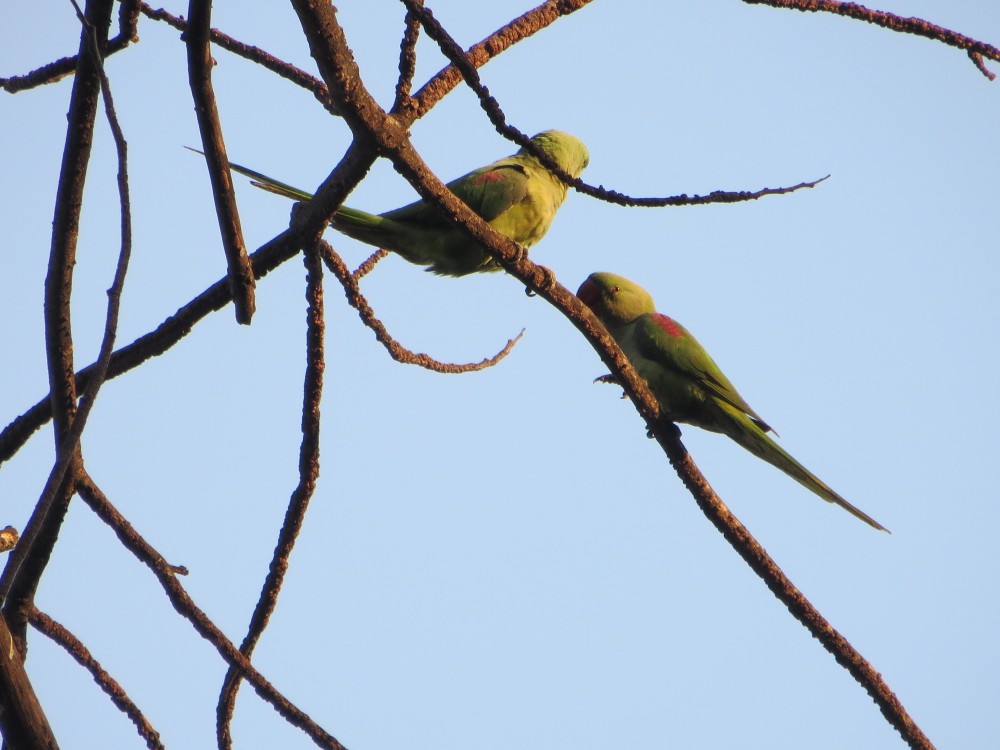Alexandrine Parakeet
A species of Ring-necked Parakeets Scientific name : Psittacula eupatria Genus : Ring-necked Parakeets
Alexandrine Parakeet, A species of Ring-necked Parakeets
Botanical name: Psittacula eupatria
Genus: Ring-necked Parakeets
Content
Description People often ask General Info
 Photo By Danish Sualeh , used under CC-BY-SA-4.0 /Cropped and compressed from original
Photo By Danish Sualeh , used under CC-BY-SA-4.0 /Cropped and compressed from original Description
The Alexandrine parakeet is one of the largest parakeets, measuring 56 to 62 cm (22 to 24 in) from the top of the head to the tip of the tail and weighing 200 to 300 g (7.1 to 10.6 oz). The tail measures 28 to 35 cm (11 to 14 in). It is predominantly green with a light blue-grey sheen on the cheeks and nape (back of the neck), yellow-green abdomen, red patch on the shoulders and massive red beak with yellow tips. The upperside of the tail passes from green at the top to blue further down, and is yellow at the tip. The underside of the tail is yellow. Adults are sexually dimorphic. Adult males have a black stripe across their lower cheeks and a pink band on their nape. Adult females lack both a black stripe across their lower cheeks and a pink band on their nape. The young are similar in appearance to adult females but have shorter tails. 
Size
62 cm
Nest Placement
Cavity
Feeding Habits
Alexandrine Parakeet primarily consume fruits, seeds, nectar, petals, and young vegetable leaves. They forage in flocks, often causing damage to orchards and cereal crops. Notably, in agricultural areas, cultivated sources constitute over 70% of their diet.
Habitat
The alexandrine Parakeet is predominantly found in dry and moist deciduous lowland forests, wooded regions including mangroves, and cultivated landscapes like coconut plantations and old gardens. This species favors areas with substantial tree growth near water sources and can inhabit subtropical zones characterized by specific flora such as the Roxburgh pine.
Dite type
Herbivorous
People often ask
General Info
Feeding Habits
Bird food type
Behavior
The Alexandrine parakeet lives in forests, woodlands, agricultural lands and mangrove forests at elevations of up to 900 m (3,000 ft). It eats a variety of wild and cultivated seeds, buds, fruits and nuts. Flocks can cause extensive damage to ripening fruits and grain crops like maize and jowar. It usually lives in small flocks, but forms larger groups in areas where food is abundant or at communal roosts. The Alexandrine parakeet has a variety of calls, including a ringing trrrieuw, loud kree-aar or keeak, deep klak-klak-klak-klak and resonant gr-aak. Its calls are usually deeper, harsher and more resonant than those of the rose-ringed parakeet. Its voice becomes harsher when alarmed, and it shrieks loudly when mobbing predators. Flocks occasionally excitedly vocalize together. It is known to imitate human speech in captivity. 
Species Status
The Alexandrine parakeet is listed as near threatened by the International Union for Conservation of Nature (IUCN) because of its steep population decline in its native range due to habitat loss, persecution and excessive capture to cater to the demands of the illegal wildlife trade. It is sporadic in South India, uncommon in Bangladesh, and declining in North Bengal and certain parts of Sri Lanka. It has suffered the greatest population declines in the Sindh and Punjab provinces of Pakistan, Laos, northwestern and southwestern Cambodia, and Thailand. The sale of Alexandrine parakeets is banned in Pakistan, but they can be found being openly sold in the markets of Lahore and Rawalpindi. Their sale is also banned in India, and yet they are sold in broad daylight in urban bird markets, suggesting that the Indian government is allocating insufficient resources for their protection. 
Scientific Classification
Phylum
Chordates Class
Birds Order
Parrots Family
Parrots Genus
Ring-necked Parakeets Species
Alexandrine Parakeet